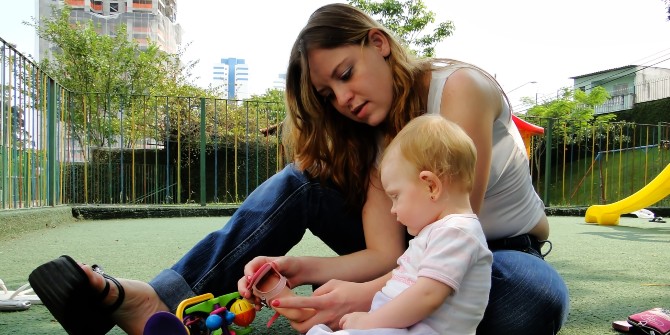Childcare costs in the UK are among the highest in the world. The government plans to relax staff to child ratios to make it cheaper but, warn Lene Hyltoft and Tracey Warren (Nottingham University Business School), improving the quality of early years provision is just as important as making it more affordable. Denmark has shown it is possible to do both.
The UK’s childcare system is now at breaking point. The cost of early years provision can be astronomical. We have some of the highest rates in the world. High costs eliminate this childcare option completely for many parents, while creating severe financial pressures for others. Combined with a lack of availability, this blocks parents’ access to employment and progression, with women most affected.
The government is reportedly planning to change the staff:child ratio in early years care settings in order to cut the costs of childcare for parents. If the changes go ahead, one member of staff will be able to look after five under-two-year-olds, compared to the current limit of three children to each adult. Relaxing the ratios would seriously undermine the quality of childcare and add even more pressure to already stretched childcare workers.
Rather than relaxing childcare ratios, prioritising the quality of early years provision and ensuring it is more affordable are both essential. The pandemic demanded swift decision-making and radical action in many policy areas. Now is a good time to review current childcare provision and to reassess where the UK should be heading.
Pandemic restrictions generated particular difficulties for workers who were parents of young children. Parents newly working from their homes had to work out how to juggle the demands of their jobs with the full-time needs of their children, and those who still had to go out to their jobs saw the number of childcare options available to them plummet. Formal child-care providers had to close their doors to most children and the range of potential informal childcare arrangements, organised within families and between friends, collapsed as the pandemic restricted contact outside ‘bubbles’.
Yet for many in the UK, the pandemic-related break from high childcare costs has been a true eye-opener. For those parents who could work from home, going back to the workplace has meant having to resume the dreaded balancing act in order to afford high nursery and childminder fees.
Compare these parents’ situations with working parents in Denmark. Returning to the post-pandemic workplace is not creating the same worries for the Danes, because of the well-functioning Danish state-subsidised childcare system. From the UK, what the Danes take for granted looks like an enviable smörgåsbord (or in Danish smørrebrødsbord) menu of quality childcare options.
In the UK, government help towards the very high expense of early years childcare is complicated but, in general for working parents, it only starts when a child reaches the age of 3 to 4. In England, it only covers up to 30 hours a week of provision, in approved childcare settings, and only for 38 weeks a year (1,140 hours).
Compare this with Denmark, where every child is guaranteed a place. There are day nurseries for the youngest children (aged 0-3), kindergartens for 3-6 year olds, plus pre-school/after school centres once children start school aged six. Moreover, the local municipality provides a subsidy of at least 75% of childcare expenses (so parents pay no more than 25%). There are even quality childcare options in Denmark for parents whose working patterns fall outside the 9-5 weekday schedules, including people working night shifts.

Childcare in Denmark is good quality and, crucially, staff are well-trained and well-paid. The law in Denmark specifies three reasons for universal childcare provision. The first is specifically to promote children and young people’s wellbeing, development, and learning. The second is to enable families to plan family and working life, with flexible options, and the third is to battle social exclusion, especially for children with extra needs.
We carried out research into the Danish experience to find out more about how work-life balance can look. Funded by a British Academy/Leverhulme Trust Small Research Grant (RA3159), and supported by the UK Department for Business, Energy and Industrial Strategy, we interviewed experts in Denmark to gain insights into the Danish success in this crucial area, including pandemic work-life experiences.
The experts we spoke to were adamant that high quality and affordable childcare is fundamental to work-life balance for parents. Christina Sode Haslund, head of working environment at the Confederation of Danish Employers, told us:
The reality is that we have day care institutions where our children can be looked after… it has become a part of our welfare model that you have this service. And this means that with peace of mind you can leave your children in daycare and work.
Dr Anders Raastrup Kristensen, a lecturer at the University of Copenhagen, told us just how stunned people in Denmark are when they hear about provision elsewhere:
I think, because you have the possibility of kindergartens and if your child can be taken care of, so you can work, and when Danish people hear about how these things are organised in Germany, or in the Netherlands and so on, we are like… ‘It can’t be true!’
UK parents of young children who are currently not in paid work, most of whom are women, are a skilled reserve army of labour that could help fill the current shortages in many occupations. Responding to major gaps in the 2021 Spending Review and Autumn Budget, Mary-Ann Stephenson, the director of the UK Women’s Budget Group, concluded: ‘Frankly, it’s worrying that the government has yet again failed to make the connection between childcare, levelling-up and economic growth’. The UK urgently needs new ideas and solutions for a better childcare infrastructure to enable parents to take paid work and to relieve the overwhelming pressure on young families. ‘Building Back Better’ must include providing affordable, quality childcare provision.
This post represents the views of the authors and not those of the COVID-19 blog, nor LSE.





